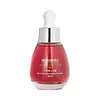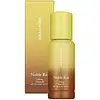What's inside
What's inside
 Key Ingredients
Key Ingredients

 Benefits
Benefits

 Concerns
Concerns

No concerns
 Ingredients Side-by-side
Ingredients Side-by-side

Rosa Centifolia Flower Water
Skin ConditioningGlycerin
HumectantHydrolyzed Collagen
EmollientNatto Gum
Wheat Amino Acids
Skin ConditioningPanax Ginseng Root Extract
EmollientOphiopogon Japonicus Root Extract
Skin ConditioningPlatycodon Grandiflorus Root Extract
AntioxidantGlycyrrhiza Glabra Root Extract
BleachingAstragalus Membranaceus Root Extract
EmollientZingiber Officinale Root Extract
MaskingLonicera Japonica Flower Extract
Skin ConditioningZanthoxylum Piperitum Fruit Extract
Skin ConditioningPulsatilla Koreana Extract
Skin ConditioningCitrus Paradisi Fruit Extract
Skin ConditioningSodium Hyaluronate
HumectantDioscorea Opposita Root Extract
Skin ConditioningHydroxyethylcellulose
Emulsion StabilisingGardenia Florida Oil
TonicTremella Fuciformis Sporocarp Extract
AntioxidantAcetyl Hexapeptide-8
HumectantXanthan Gum
EmulsifyingAdenosine
Skin ConditioningDisodium EDTA
Rosa Centifolia Flower Water, Glycerin, Hydrolyzed Collagen, Natto Gum, Wheat Amino Acids, Panax Ginseng Root Extract, Ophiopogon Japonicus Root Extract, Platycodon Grandiflorus Root Extract, Glycyrrhiza Glabra Root Extract, Astragalus Membranaceus Root Extract, Zingiber Officinale Root Extract, Lonicera Japonica Flower Extract, Zanthoxylum Piperitum Fruit Extract, Pulsatilla Koreana Extract, Citrus Paradisi Fruit Extract, Sodium Hyaluronate, Dioscorea Opposita Root Extract, Hydroxyethylcellulose, Gardenia Florida Oil, Tremella Fuciformis Sporocarp Extract, Acetyl Hexapeptide-8, Xanthan Gum, Adenosine, Disodium EDTA
Bergamot/Grapefruit/Orange/Tangerine Fruit Ferment Extract
AntioxidantHydrogenated Polydecene
EmollientButylene Glycol
HumectantGlycerin
HumectantPropanediol
Solvent1,2-Hexanediol
Skin ConditioningHydrolyzed Glycosaminoglycans
HumectantSodium Hyaluronate
HumectantSodium Hyaluronate Crosspolymer
HumectantHydrolyzed Hyaluronic Acid
HumectantHydroxypropyltrimonium Hyaluronate
Hyaluronic Acid
HumectantSodium Acetylated Hyaluronate
HumectantSodium Chloride
MaskingWater
Skin ConditioningTocopheryl Acetate
AntioxidantCellulose Gum
Emulsion StabilisingEthylhexylglycerin
Skin ConditioningCapryloyl Salicylic Acid
ExfoliatingAdenosine
Skin ConditioningHydroxyethylcellulose
Emulsion StabilisingDextrin
AbsorbentGardenia Taitensis Callus Extract
AntioxidantTheobroma Cacao Extract
Skin ConditioningBenzyl Glycol
SolventArginine
MaskingCarbomer
Emulsion StabilisingAlcohol Denat.
AntimicrobialC12-14 Pareth-12
EmulsifyingPoloxamer 407
EmulsifyingBHT
AntioxidantRaspberry Ketone
MaskingDisodium EDTA
Bergamot/Grapefruit/Orange/Tangerine Fruit Ferment Extract, Hydrogenated Polydecene, Butylene Glycol, Glycerin, Propanediol, 1,2-Hexanediol, Hydrolyzed Glycosaminoglycans, Sodium Hyaluronate, Sodium Hyaluronate Crosspolymer, Hydrolyzed Hyaluronic Acid, Hydroxypropyltrimonium Hyaluronate, Hyaluronic Acid, Sodium Acetylated Hyaluronate, Sodium Chloride, Water, Tocopheryl Acetate, Cellulose Gum, Ethylhexylglycerin, Capryloyl Salicylic Acid, Adenosine, Hydroxyethylcellulose, Dextrin, Gardenia Taitensis Callus Extract, Theobroma Cacao Extract, Benzyl Glycol, Arginine, Carbomer, Alcohol Denat., C12-14 Pareth-12, Poloxamer 407, BHT, Raspberry Ketone, Disodium EDTA
Alternatives
Ingredients Explained
These ingredients are found in both products.
Ingredients higher up in an ingredient list are typically present in a larger amount.
Adenosine is in every living organism. It is one of four components in nucleic acids that helps store our DNA.
Adenosine has many benefits when used. These benefits include hydrating the skin, smoothing skin, and reducing wrinkles. Once applied, adenosine increases collagen production. It also helps with improving firmness and tissue repair.
Studies have found adenosine may also help with wound healing.
In skincare products, Adenosine is usually derived from yeast.
Learn more about AdenosineDisodium EDTA plays a role in making products more stable by aiding other preservatives.
It is a chelating agent, meaning it neutralizes metal ions that may be found in a product.
Disodium EDTA is a salt of edetic acid and is found to be safe in cosmetic ingredients.
Learn more about Disodium EDTAGlycerin is already naturally found in your skin. It helps moisturize and protect your skin.
A study from 2016 found glycerin to be more effective as a humectant than AHAs and hyaluronic acid.
As a humectant, it helps the skin stay hydrated by pulling moisture to your skin. The low molecular weight of glycerin allows it to pull moisture into the deeper layers of your skin.
Hydrated skin improves your skin barrier; Your skin barrier helps protect against irritants and bacteria.
Glycerin has also been found to have antimicrobial and antiviral properties. Due to these properties, glycerin is often used in wound and burn treatments.
In cosmetics, glycerin is usually derived from plants such as soybean or palm. However, it can also be sourced from animals, such as tallow or animal fat.
This ingredient is organic, colorless, odorless, and non-toxic.
Glycerin is the name for this ingredient in American English. British English uses Glycerol/Glycerine.
Learn more about GlycerinHydroxyethylcellulose is used to improve the texture of products. It is created from a chemical reaction involving ethylene oxide and alkali-cellulose. Cellulose is a sugar found in plant cell walls and help give plants structure.
This ingredient helps stabilize products by preventing ingredients from separating. It can also help thicken the texture of a product.
This ingredient can also be found in pill medicines to help our bodies digest other ingredients.
Learn more about HydroxyethylcelluloseSodium Hyaluronate is hyaluronic acid's salt form. It is commonly derived from the sodium salt of hyaluronic acid.
Like hyaluronic acid, it is great at holding water and acts as a humectant. This makes it a great skin hydrating ingredient.
Sodium Hyaluronate is naturally occurring in our bodies and is mostly found in eye fluid and joints.
These are some other common types of Hyaluronic Acid:
Learn more about Sodium Hyaluronate